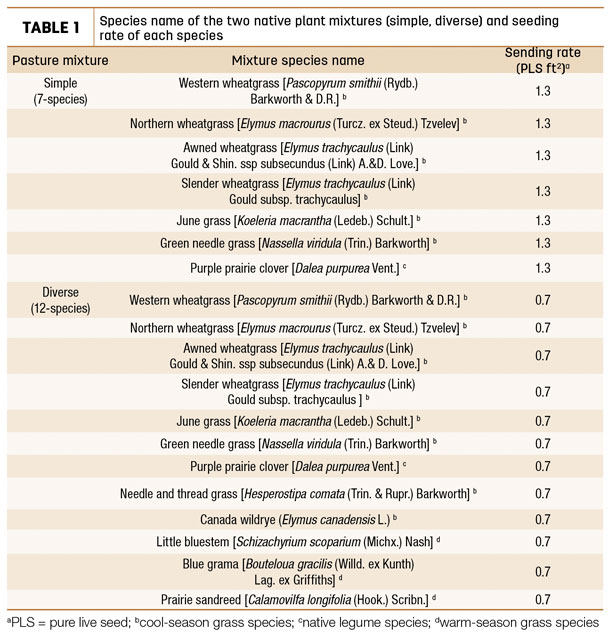The Great Plains is the major grassland of North America and extends from the boreal forest in Canada (Alberta, central British Columbia, Manitoba and Saskatchewan) all the way south to the Mexican border. In the Great Plains, only half of the grasslands remain intact, and the temperate grasslands continue to be converted to crops and other land uses. As a result, temperate grasslands are recognized as the world’s most endangered ecosystem.
Grasslands are important to improve the quality of our soil, air and water, and enhance biodiversity. The rooting systems of grasslands store a significant amount of carbon (34% of the terrestrial global carbon stock) from the atmosphere, providing a stable carbon sink and helping mitigate climate change impacts. Thus, maintaining our grasslands and better understanding their potential to sequester soil organic carbon is important.
We initiated a pasture and grazing research project in 2000. Recently, researchers with agricultural ecosystem modeling expertise from the Lethbridge Research and Development Centre joined the research collaboration. The study was aimed to determine the effects of grazing management and different native grass and legume mixtures (Table 1) on soil organic carbon of a re-established native Canadian grassland.

The native mixtures were seeded in 2001 on 16 paddocks of 5 acres that had a cropland history of wheat and fallow first cultivated in the 1920s.
The study (2000 to 2017) was a completely randomized design (rep = 2) with seven simple species (western wheatgrass, northern wheatgrass, awned wheatgrass, slender wheatgrass, June grass, green needle grass and purple prairie clover) and more diverse native mixes (12 species: the same species in the seven-mix plus, needle-and-thread grass, Canada wildrye, little bluestem, blue grama and prairie sandreed) and under either a continuous or deferred-rotational grazing (DRG) system.
There were three groups in the DRG system that started grazing at a different grazing season period (spring, summer or fall) at the start of the study. Each group consisted of four pastures (two seven-mix and two 12-mix) and, over the course of three years, all three grazing season periods occurred for each paddock type. Four paddocks (two seven-mix and two 12-mix) were used for the continuous grazing system.
Each paddock contained an ungrazed enclosure, and paddocks were grazed (50% utilization) by Angus yearling steers (758 plus or minus 37 pounds) from 2001 to 2017. The grazing period started in the end of June and ended by August for continuous grazing and lasted until the end of September for DRG. The continuous grazing and DRG stocking rates were 1.7 and 4.5 animal units per acre, respectively. Plant biomass, litter and dung were measured. Bulk density and soil organic carbon measurements occurred at three or five micro-sites per paddock at four depths (zero to 6, 6 to 12, 12 to 18 and 18 to 24 inches).
A paper published in 2019 on the first 14 years of soil organic carbon results from the zero to 12 inches depth observed that the smallest soil organic carbon content occurred for the simple native mix under continuous grazing, while significantly higher soil organic carbon was found for both the simple native mix under DRG and the diverse native mix under continuous grazing.
An explanation for the results could be due to more diverse native mixture or a more ecological sustainable grazing system, resulting in higher carbon sequestration. However, it is unclear why this was not shown in the more diverse native mix under DRG, which had soil organic carbon levels similar to all of the treatment combinations except the treatment with the smallest soil organic carbon.
Numerous North American studies have found no clear relationships on the effects of different forage species composition and grazing treatments on soil organic carbon, especially in the short term. Therefore, it may require more than several decades to address carbon variability due to environment-forage-animal-soil-microbial interactions, particularly for arid and semiarid agro-ecosystems. In the future, different mathematical models will be used to compare predicted soil organic carbon values over a longer period of time to the actual data collected in this current study.
Furthermore, recent research results evaluating the data for the first 14 years found that most of the soil organic carbon change was in the upper 12 inches. In subsequent years, the additional soil organic carbon between 12 to 18 inches and 18 to 24 inches was most pronounced in 2017, and most of the soil organic carbon change was now below 12 inches.
These results support the need for long-term research to evaluate the effects of perennial forages to sequester soil organic carbon. Native plants typically have deeper and more extensive rooting systems to help them survive dry conditions, and it appears it can take several decades before native species start affecting soil organic carbon content at lower depths.
The average carbon sequestration rates from 2000 to 2017 for the re-established native study in the semiarid eco-region of southern Saskatchewan were not large; however, the extensive amount of marginal land that could be converted back to perennial forages and existing native grasslands that could be rejuvenated (enhance specie diversity) and/or the adoption of different grazing management could result in significant carbon being sequestered in North America grasslands.
R. Kroebel is with Agriculture and Agri-Food Canada - Lethbridge Research and Development Centre.
References omitted but are available upon request. Click here to email an editor.








